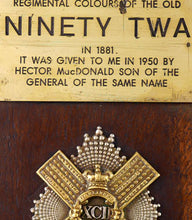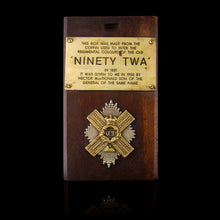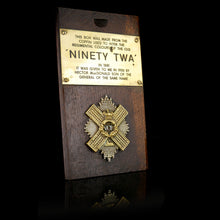92nd Gordon Highlanders - Fragment of the Coffin for the Old Colours, 1881
Adding product to your cart
23.5cm (9.2in) x 13.5cm (5.3in)
Provenance:
Major-General Sir Hector Macdonald, KCB, DSO (1853-1903)
Hector Duncan Macdonald (1887-1951)
Oak and brass. A section of a box lid applied with a 92nd Gordon Highlanders officer's shoulder belt plate and plaque engraved ‘This box was made from the coffin used to inter the regimental colours of the old 'Ninety Twa' in 1881. It was given to me in 1950 by Hector Macdonald, son of the General of the same name.’
Read more
On 1 July 1881 under reforms introduced by the Secretary of State for War Hugh Childers the 92nd Gordon Highlanders were amalgamated with the 75th (Stirlingshire) Regiment of Foot to form the Gordon Highlanders. The news was met with dismay by Second Lieutenant Macdonald and other veterans of the recent war in Afghanistan, not to mention the desperate fight on Majuba Hill where Macdonald’s bearing up to the point of surrender had so impressed the Boers that General Joubert returned his sword. Moreover, ’ … as it [the amalgamation] meant sharing the Gordon name with another regiment, and they [the 92nd] were determined to mark the occasion with due respect. At midnight on the 30th June, while they were still stationed in the Drakensberg Mountains, a mock funeral was held by torchlight and a coffin containing the flag [sic] of the 92nd was lowered into the ground with due solemnity. An oration was delivered by the graveside, volleys fired, the Dead March played by the band and a piper played a lament beneath the gleaming stars. It was a solemn moment meaning much to the officers and Macdonald remembered in his will to gift to his son, Hector, his photograph of the burial of the "puir auld ninety-twa". On a lighter note, the next morning dawned to find the flag, exhumed and scrawled beneath the 92, the defiant slogan "No deid yet!” In the final event the old Regimental Colours of the 92nd were laid-up in St Giles' Cathedral, Edinburgh, some two years later by the Duke of Cambridge, where they remain to the present day.
Major-General Sir Hector Macdonald (1853-1903), the son of a crofter, rose through the ranks purely on his own merit and professionalism to become a nationally known personality. He distinguished himself during the Second Afghan War and was offered the choice of the Victoria Cross or a commission. He chose the latter, but never quite fitted in with his fellow officers. He was later posted to Ceylon as Commander-in-Chief of British forces, but committed suicide in 1903 following accusations of homosexual activity by hostile elements in the colony. The circumstances of his death divided opinion and shocked the public, as did the fact that he had secretly married in 1884 and had fathered a son, Hector.






